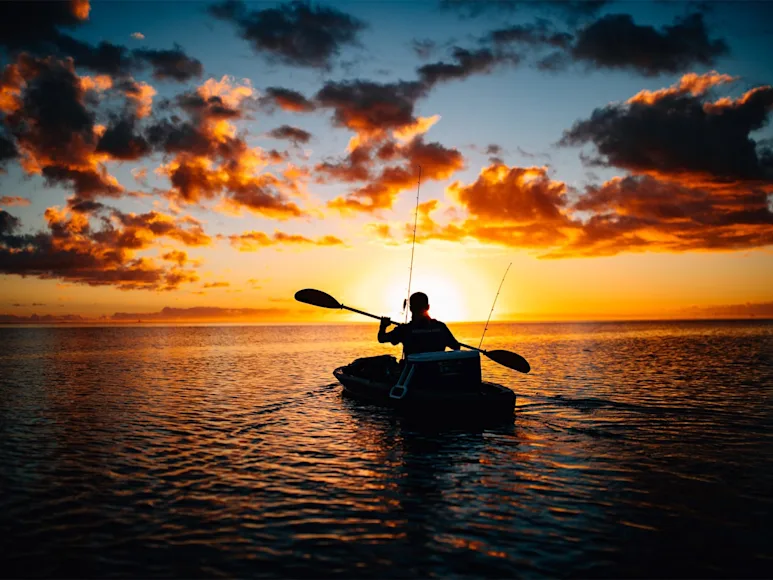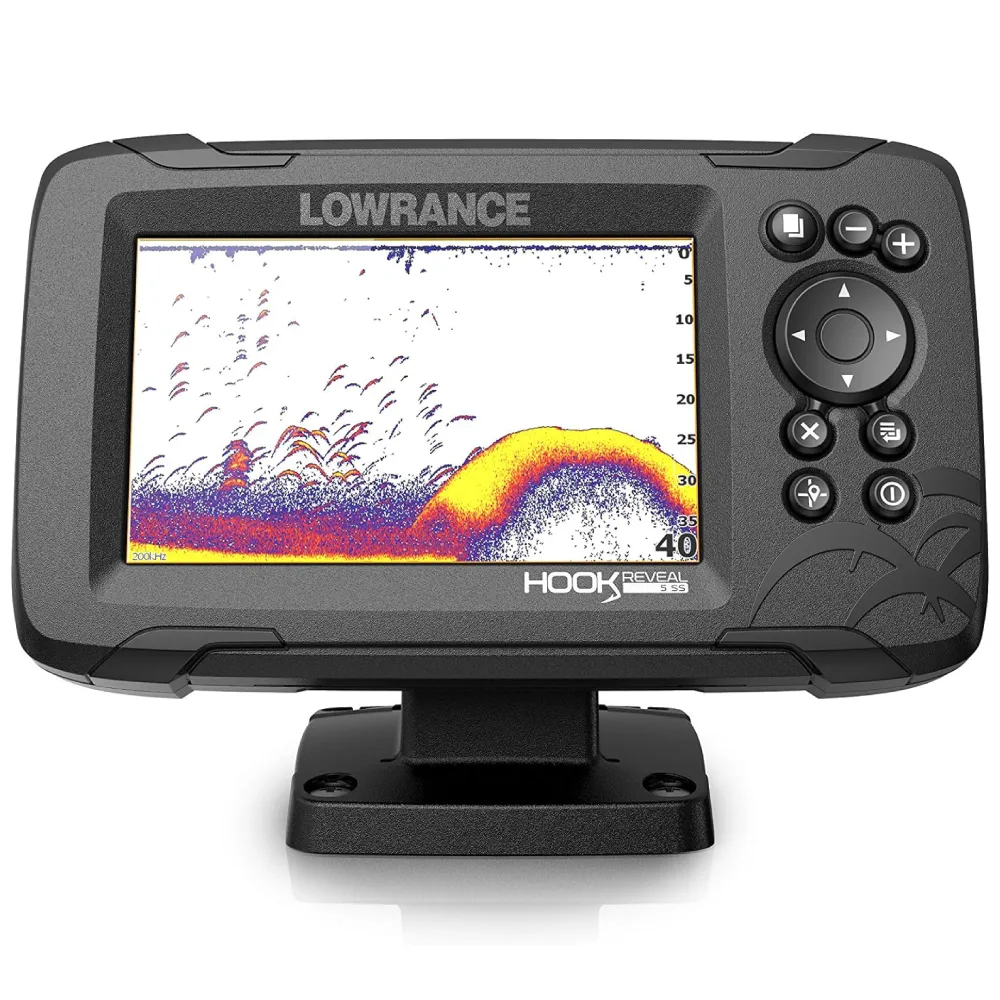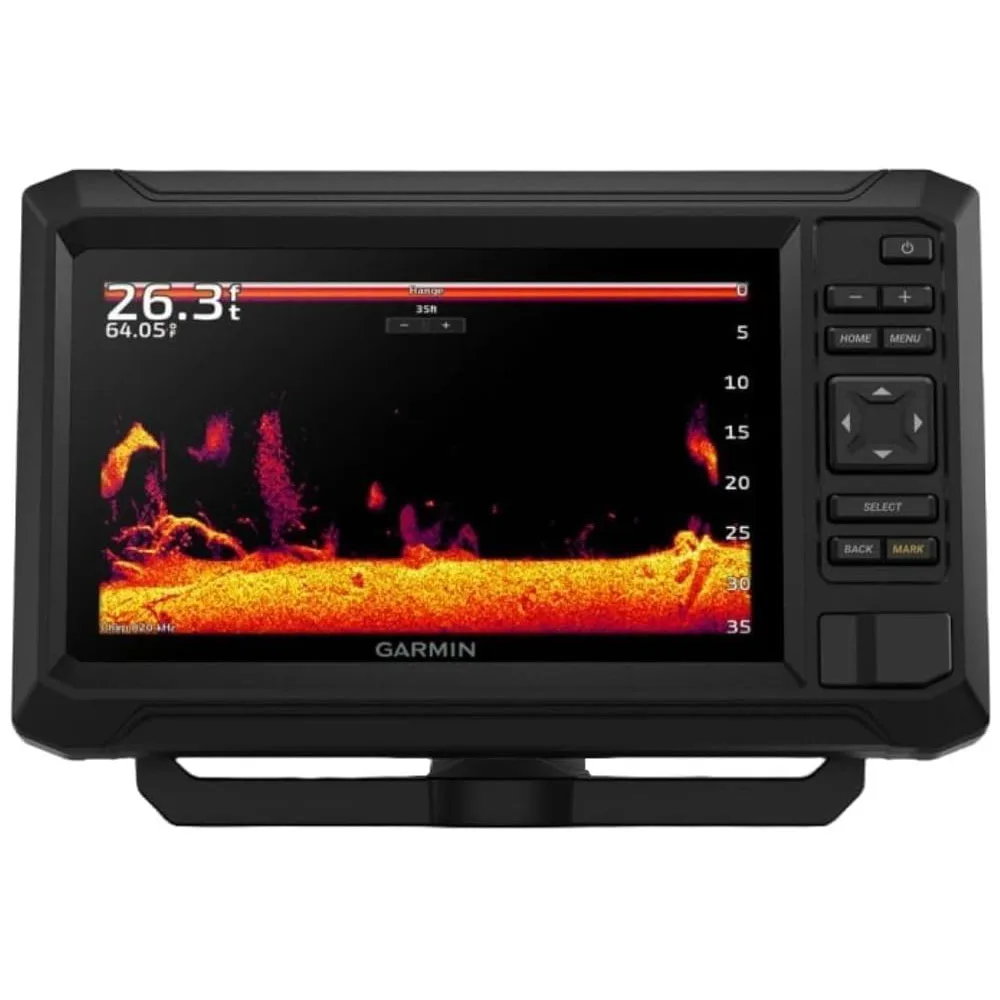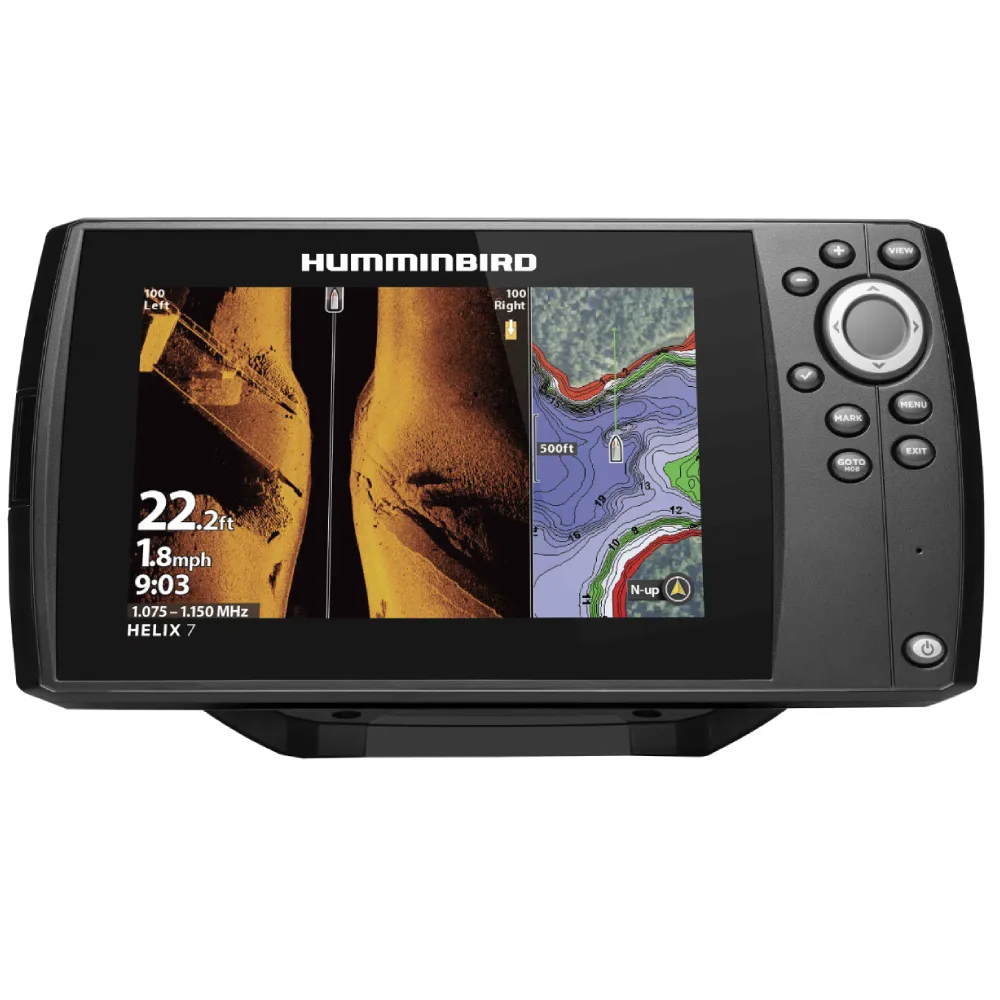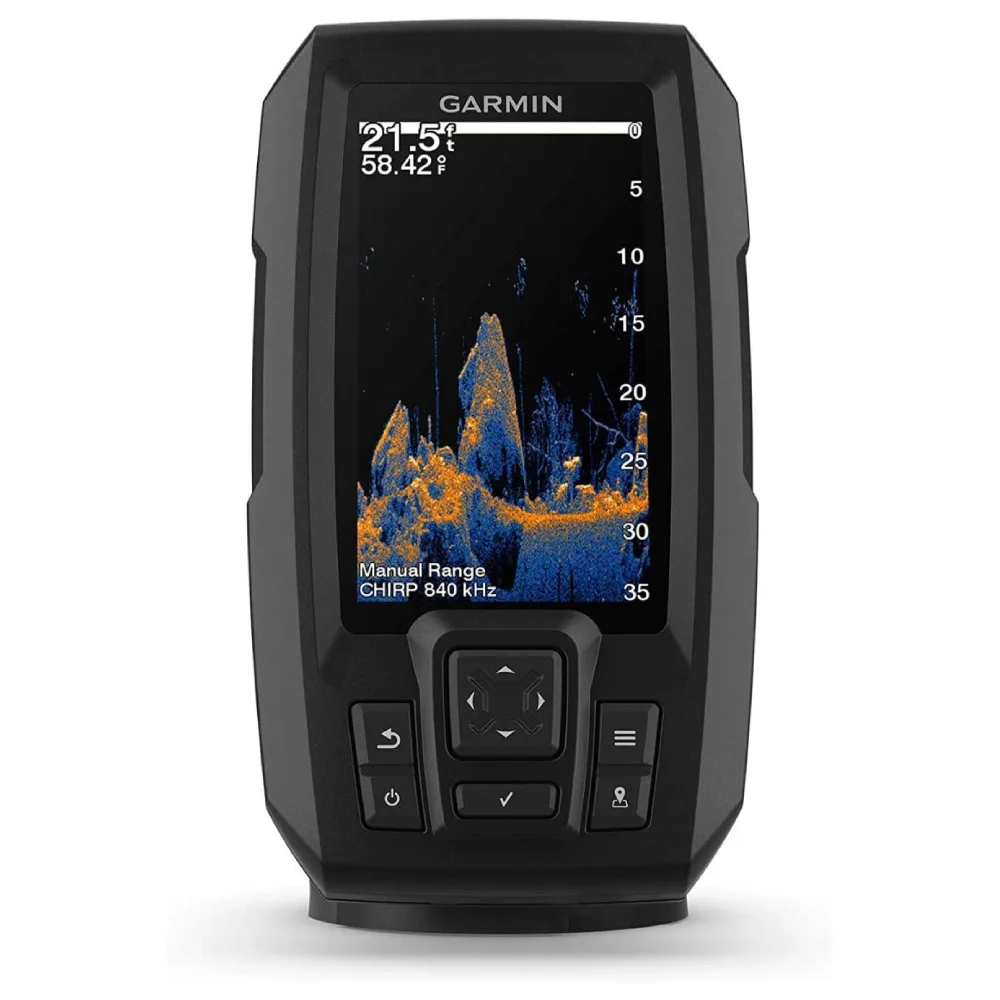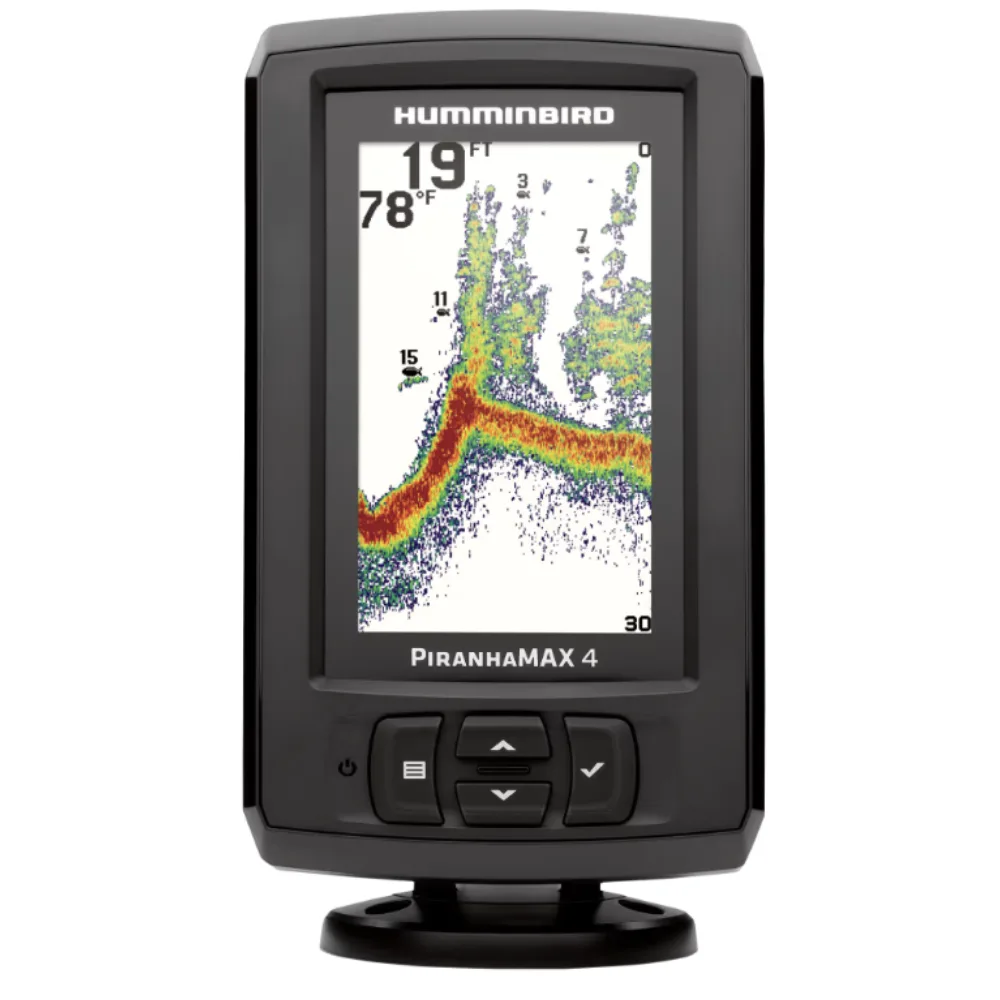We may earn revenue from the products available on this page and participate in affiliate programs. Learn more ›
After buying a fishing kayak, paddle, and life vest, the next logical step for most anglers is adding a kayak fish finder. Some anglers want only a compact or portable fish finder with limited features. Others demand side view and 360-degree imaging. And a fish finder with GPS adds a powerful navigation tool to stay on course and monitor speed.
All this impacts cost—you can get a basic model for less than $100, or break the piggy bank and get one with everything. Below, we’ve rounded up the best fish finders for kayaks available right now, from Lowrance, Humminbird, Garmin, and more.
Best Overall: Lowrance Hook Reveal 5
Best Fish Finder GPS: Garmin ECHOMAP2 UHDCV 73CV
Best with Side Imaging: Humminbird Helix 7
Best Compact: Garmin Striker Vivid 4CV
Best Portable: Deeper Chirp 2
Best Budget: Humminbird PiranhaMax 4
Best Overall: Lowrance Hook Reveal 5
Specs
Screen Size: 5 inches
Dimensions: 9.02 X 7.13 X & 7.52
Control Method: Touchscreen & buttons
Pros
Perfect size for a kayak
Durable
Easy to read
Cons
Expensive
The Lowrance Hook Reveal 5 was designed with kayak fishing in mind. The 5-inch waterproof screen is out of the way and easy to see from the kayak seat. Large buttons can be pushed with a paddle blade or rod tip. A special coating on the screen keeps the display visible in direct light. Not only can it take a beating, but the Hook Reveal 5 packs a punch. The auto-tuning sonar adjusts settings based on water and bottom conditions. To accommodate kayak anglers, the Splitshot transducer is sized to fit in a scupper and still provide Chirp and DownScan signals.
The Fish Reveal screen combines the target separation of Chirp with detailed DownScan images. Lowrance offers an easy installation kit that provides a solid mounting solution that takes five minutes to install and stays out of the way. To find the fish quickly and stay on the bite, the Hook Reveal 5 has a basic GPS plotter. You can mark waypoints, monitor speed and distance, and navigate with confidence.
Best Fish Finder GPS: Garmin ECHOMAP2 UHDCV 73CV
Specs
Screen Size: 7 inches
Dimensions: N/A
Control Method: Touchscreen & buttons
Pros
Big, readable screen, even bright sunlight
Preloaded with Navionics maps
Sonar sharing capabilities with other Echomap plus units
Cons
Expensive
Adding a GPS to a fish finder packs two valuable tools in one package. Kayak anglers are always looking to save space, so the best sonar fish finder for a kayak should double as a high-powered GPS. Fish finders vary widely in signal technology and display quality, and all GPS units are not created equal. Garmin’s Echomap UHD 74/Cv combines a high-powered, full feature fish finder with high quality and detailed navigation chart—it’s one of the best Garmin fish finders out there.
The Echomap 74/CV has an easy-to-read, glare-resistant touch screen that is supported with push buttons. Even if your hands are covered with fish slime and swamp muck, you can go from touch screen to buttons without losing functionality. The ECHOMAP 74′s seven inch screen is large enough to see split screens but small enough to stay out of the way.
The 74cv comes with a transducer for high-definition traditional sonar and CHIRP sonar. Traditional sonar uses a single beam to produce detailed images of fish and bait and the best return in deeper water. CHIRP shoots multiple signals at different frequencies to create a stereophonic, almost three-dimensional image of structure. The display is vivid and clear and the colors and contrast can be adjusted to provide a clear video of fish swimming below.
Hosting Garmin’s detailed Bluechart G3 maps, the GPS relies on high quality navigation charts that are constantly updated. High-contrast bathymetric readings make it easy to find structure and navigate the backwaters. Users can edit the map with custom information for even more accurate navigation.
It also has a smartphone app that can connect with the ECHOMAP’s brain to update charts and add user notes. The app allows you to take your charts with you to plan a fishing trip when you’re away from the kayak.
Best with Side Imaging: Humminbird Helix 7
Specs
Screen Size: 7 inches
Dimensions: N/A
Control Method: Buttons
Pros
Clear images
125 feet range of side imaging
Includes Navionics+
Cons
Expensive
Interface is not user friendly
The Humminbird Helix 7 MEGA SI GPS G3 uses high powered signals to produce the most detailed depiction of fish and structure on the side of a kayak. The Mega side imaging fish finder uses the most powerful sonar signal available to create high definition images of structure and fish clear enough for users to distinguish between individual fish and even species. The Mega Down Imaging uses the same technology to display a three-dimensional image of structure and fishing hiding within. Humminbird’s Dual Spectrum CHIRP shoots two sonar signals at different frequencies for a more detailed sonar return. The signal cone can be set to wide view for increased coverage or narrow for improved detail. The traditional SwitchFire sonar image uses bright, high-contrast colors for the ultimate in target separation to differentiate bait schools from schools of fish.
In addition to high-quality sonar, the Helix 7 also has a basic navigation map and bathymetric chart. The base GPS is perfect for setting a course and monitoring speed and track, and can be upgraded with more advanced mapping software. Check out more of the best Humminbird fish finders to compare.
Best Compact: Garmin Striker Vivid 4CV
Specs
Screen Size: 4 inches
Dimensions: 8 x 11.5 x 6 inches
Control Method: Buttons
Pros
Vivid scanning sonar
Includes Chirp traditional sonar and CHIRP ClearVü scanning sonar
High-sensitivity GPS
Affordable
Cons
Small screen
The Garmin Striker Vivid 4cv fish finder squeezes a top quality sonar and editable GPS plotter into a four-inch fish finder. It has traditional dual-beam CHIRP sonar along with high-definition Chirp ClearVu sonar. Use the Chirp when searching for fish and structure, then switch to the ClearVu down scan sonar to explore a hot spot in detail.
To complement the powerful sonar, Garmin included a high sensitivity GPS with Quickdraw Contours mapping. Users can mark waypoints and monitor course and speed. Then, tie the GPS into the fish finder and record depth contours to create a custom map covering up to 2 million acres. The bright, high-contrast color screen provides clear views of maps and sonar images, and allows you to choose from seven different color schemes so you choose the one that provides the clearest view for the conditions.
Best Portable: Deeper Chirp 2
Specs
Screen Size: Phone
Dimensions: Ball
Control Method: Smartphone
Pros
Castable
Sends a signal to 394 feet
Strong battery life
Cons
Not ideal for boats
Deeper’s concept for a portable fish finder is simple: The angler ties the golf-ball-sized transducer to a fishing line and casts it away from the boat. A Wi-Fi signal from the transducer sends images of the bottom and fish to a full-color display on a smartphone app. The Deeper CHIRP technology sends signals at different frequencies to create a more detailed image. It has three beam angles, allowing for a wide view of an area or a focus on a specific target.
It takes accurate readings in water up to 330 feet deep, and the Wi-Fi signal works up to 330 feet from the boat. If you don’t want to cast the transducer, an adapter allows you to connect the transducer to the kayak, so it works like a traditional bottom machine without cables or a battery. Users can store and search information in the fishing log and share pictures and stories with other angles on the Deeper network.
Best Budget: Humminbird PiranhaMax 4
Specs
Screen Size: 4.3 inches
Dimensions: N/A
Control Method: Buttons
Pros
Affordable
Dual-beam sonar
Depth sonar up to 320 feet
Cons
Only sonar capable
No GPS
As fish finder technology advances, savvy anglers can get top-of-the-line features at a great price. The Humminbird Piranhamax 4 costs less than $100 and still produces a high-definition color image of fish and the bottom. The 256-color display provides high-contrast target separation between fish and bait. The wide range of colors also allows the user to determine hard bottom from soft.
The bright, 4.3-inch color display is supported by a high powered, dual-frequency transducer. At 2400 watts PTP power output, the transducer sends two signals simultaneously to pick up even small baitfish and the slightest change in bottom contour.
How We Tested Fish Finders for Kayaks
There is only one way to make the best recommendations for fishing gear, and that’s on-the-water testing. We have used and tested most of the models recommended below. We have also talked to manufacturers and industry professionals about what they look for in kayak fish finders. We based our selections on the criteria below.
Portability: How easy is the fish finder to install and take out? Is it built for a mobile rig?
Screen: How big is the screen? Can it withstand being out in the sunlight? Can you read it in direct sunlight?
Technology: Does it have a GPS? What about down view scanning and side imaging? All important considerations.
Durability: Can the unit withstand the rugged abuse of being out in the elements all day? Kayaks do not offer much protection for electronics.
Buying Guide
A fish finder is a complicated and powerful tool that has to survive life on board a kayak. That means this kayak fishing gear must be tough enough to survive constant exposure to sun, water, and dirt. It should have the highest level of waterproofing, an easy-to-read screen, and corrosion-resistant electrical connections.
The unit must be simple to install with accessories and components aimed at saving space and improving performance. Many companies offer installation kits and transducer options to fit any boat. The screen should be easy to view in any light conditions with a waterproof housing willing to get banged around. The transducer has to fit in a scupper and the cable should be easy to route to the display. Same for the battery, which will be stored out of the elements and in easy reach.
Size
A fish finder should never get in the way of your fishing or paddling. If you don’t have a lot of room on your yak, consider a compact fish finder. A compact kayak fish finder has a 4-inch screen. The footprint of the base can fit in the palm of a hand. A full-color display, and mounting the fish finder close to the seat, will improve visibility.
Some compact units also feature GPS and dual beam transducers for high-resolution CHIRP sonar, giving you the best technology in a small package. Another advantage is a compact fish finder requires less power to operate, allowing the angler to choose a lighter, smaller battery and still fish all day.
Portability
If you don’t have room for a fish finder, don’t want to install a mount for one, or simply don’t want to set up and remove the fish finder display and battery before and after each trip, a portable fish finder is a good solution. Wireless fish finders for kayaks cut the cord and replace it with a Wi-Fi connection and smartphone app. The smallest portable fish finder systems revolve around a sphere slightly larger than a golf ball that houses the transducer.
GPS Technology
In addition to a fish finder being a fish finding tool, many kayak anglers want it to be a navigation tool too. That makes sense, because combining a fish finder and GPS allows you to keep an eye on the fish and structure below the boat while mapping a course and tracking speed. Using the unit in split screen mode means you can do both at the same time.
Fish finder and GPS combos come in screen sizes down to four inches, but a larger screen is easier to see from the seat. High contrast display with large numbers improves visibility. The best units have adjustable color and brightness, too.
A crucial feature is the map. The best fish finder GPS for kayak fishing will have detailed maps that are regularly updated. Some units allow the angler to edit maps with notes and even transfer depth information from the fish finder.
A GPS-enabled fish finder allows you to track drifts, mark waypoints, monitor speed, and measure distance to a destination. Moreover, navigating on a course saves time and energy. Most important, a GPS and fish finder combo is a valuable safety tool, keeping the paddler from getting lost and, in an emergency, providing rescuers with a location. For anglers fishing large lakes, in wilderness areas, or on the ocean, a GPS is essential kayak fishing equipment.
Side-Imaging Technology
Side view fish finders send a signal to the side of the transducer to capture images of fish and structure to the right and left of the boat. Fish finders with a 360 degree transducer do the same in all directions to create a live view of fish swimming by. Those with CHIRP technology use signals at various frequencies to create a more detailed image of fish and structure. Those signals can distinguish a bass from a bluegill and rocks from trees.
The biggest challenge to installing a side-imaging sonar in a kayak is fitting the large transducer. Some kayaks have a special scupper to accommodate a side-imaging transducer. If the boat isn’t designed for side imaging, anglers can mount the transducer on an arm that hangs over the side of the kayak. To rotate a live-view sonar, attach the transducer to a trolling motor or a pole dangling in the water.
Believe it or not, a kayak is a perfect platform for side view fish finders. The shallow draft and minimal turbulence give the transducer a clear, unobstructed view of the surroundings.
Price
With all the advancements in fish finder technology, the biggest step forward has been lowering the price. Today, anglers can have powerful features in the best fish finders for kayak under $100.
To get the most bang for the buck, the best budget fish finders for kayaks have fewer features but retain the highest quality components. A high resolution color display and glare resistant screen are standard. These units don’t skimp on the fish finder features either, for the best sonar signal they use dual beam transducers to produce detailed images of fish and structure.
Budget conscious anglers are looking for a cheap fish finder for kayak. Luckily, a lower price doesn’t mean cheap, these fish finders are built tough with sturdy housing and durable push buttons. To save a few bucks, low-priced fish finders offer limited features, but the quality of the sonar and display produces the best possible image.
FAQs
Q: Can you put a fish finder on a kayak?
The question isn’t can you install a fish finder on a kayak, but how will you install the fish finder. It’s a three step process, because you need to mount the transducer, the display, and the battery.
For the best results, install the transducer below the water and away from turbulence. Many kayaks have a special transducer scupper to place the fish finder below the water line and run the cable to the display.
Some boats use a removable pod that fits through the deck. Attach the display to the top of the pod, place the battery inside and install the transducer to the bottom of the pod. Not only does the pod make it easy to install the fish finder, but it only takes a second to remove the whole unit after each trip.
Without a transducer scupper or pod, the best option is to use a transducer arm. The arm attaches to a gear track and holds the transducer over the side of the kayak.
To mount the display, find a place in easy reach but out of the way of rods and paddles. Use an adjustable fish finder bracket to attach the display to the deck. Either mount the base directly to the plastic, or use a gear track to hold the fish finder mount.
Finally, find a place in the center of the kayak, close to the seat, to place the battery. Use a battery box to protect the battery from water and damage.
Q: Can a fish finder get wet?
The best fish finders for a kayak will be built to survive constant exposure to the elements. Fish finders with high IPX ratings are waterproof, dustproof and damage resistant. Look for plugs that are protected from moisture and dirt. Mount the fish finder display in a location that is most protected from swinging paddle blades. The weak link is the connection to the battery. Use heat-shrink terminal connectors and treat all electrical connections with dielectric grease.
Q: How does a fish finder work on a kayak?
A fish finder works on a simple principle: shoot a sonic wave through the water and record how the wave bounces off fish and structure. Traditional sonar shoots a cone-shaped signal directly below the transducer. Side scan sonar sends the signal down and to the sides. New forward-seeing sonar shoots a signal, like a video camera, in front of the kayak. The return signal is sent to the display unit where it is processed to provide a detailed image of fish and structure.
On a kayak, a fish finder works wonderfully. There is less turbulence and a kayak moves slowly, improving the signal’s ability to record data.
Why Trust Us
For more than 125 years, Field & Stream has been providing readers with honest and authentic coverage of outdoor gear. Our writers and editors eat, sleep, and breathe the outdoors, and that passion comes through in our product reviews. You can count on F&S to keep you up to date on the best new gear. And when we write about a product—whether it’s a bass lure or a backpack—we cover the good and the bad, so you know exactly what to expect before you decide to make a purchase.

